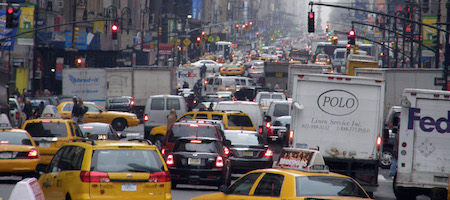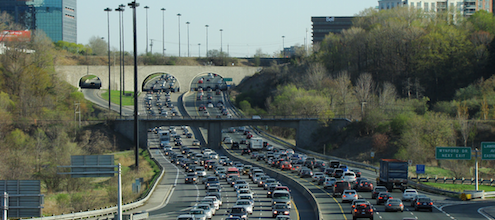
The Big Apple Plans to Take A Bite Out of Congestion
Four things we can learn from the Move NY Fair Plan
Reducing gridlock and addressing challenges in funding transportation are high on the agenda of many cities. Congestion reducing fees—for example, through HOT lanes and bridge tolls—are often missing from the toolkit, though a key piece of the puzzle. New York City is currently advancing a plan to reform tolling in a way that could reduce congestion and boost revenue for transport. What can Canadian cities learn from NYC’s past failures and current efforts?
NYC’s Plan to Reform Tolling
In a 2014 interview, former NYC Traffic Commissioner “Gridlock” Sam Schwartz noted that while New York’s Metropolitan Transportation Authority was set to raise transit fares for the 7th time in 15 years “there is one traveler that hasn’t seen any change in the cost of travel […] that’s the person that drives into Manhattan.” (Schwartz is a panelist at our November 2nd Google Hangout and yes, he popularized the term ‘gridlock’).
A 2008 plan to introduce a fee to enter or travel within part of the borough of Manhattan by car did not get through the State legislature. Now, the Big Apple is trying to move forward with a new plan to reform tolling in the city. Key goals of the Move NY Fair plan are to reduce congestion and help fund transportation infrastructure in a way that is fair to residents. And this time, success seems more likely. In an article from earlier this year, Eric Jaffe from The Atlantic’s CityLab (also on our November 2nd panel) laid out why he thinks the plan will succeed.
Two elements of the plan could be particularly helpful for reducing congestion:
- Balancing tolls: A “toll swap”, adding tolls to bridges and roads entering the CBD in lower Manhattan, and reducing tolls on other bridges around the boroughs of the city would reduce “bridge shopping” and the associated congestion and safety impacts.
- Introducing time of day pricing: Variable pricing (with higher rates at busier times) would provide an incentive to flexibly change travel patterns. Drivers could, for example, switch to transit or drive at a different time in response—whatever people choose. The Move NY plan strongly recommends incorporating time of day pricing.
Lessons for Canadian Cities?
The Big Apple’s efforts in advancing the Move NY Fair Plan reveal 4 lessons that could benefit Canadian cities should they consider new congestion pricing policies:
1. Build A Big Tent
The Move NY plan has gained support from a few organisations that may not seem like intuitive supporters of congestion pricing. For example the New York State Motor Trucking Association and the American Automobile Association—which has the mandate to represent automobile users—is backing the plan. Schwartz noted that the AAA makes for “strange bedfellows”. Better understanding the benefits of congestion pricing can help stakeholders to see that a well-designed plan may very well benefit them, and serve the greater good. Which brings us to the next point:
2. Make it Mean Something to People
When asked last year about both new and rejected plans, support was higher for the new plan. (The earlier, somewhat similar plan to price congestion in the city may have had sufficient public support but hit State roadblocks.) The higher support for the current plan suggests that this time, the benefits are more widely appreciated. In particular, the current plan is still congestion pricing, but the idea of “tolling reform” may have made the policy clearer to residents.
3. Think About the Region as a Whole
In NYC’s 2008 congestion pricing plan, much opposition came from the burrows outside Manhattan. In the current, redesigned Move NY Fair plan—which still charges most vehicles to drive into Manhattan—suburban support in particular is highest. As the name suggests, the plan emphasizes fairness, spreading out tolls across more bridges than are now tolled. The plan seeks to add a $5.54 toll to enter the CBD (which would vary if time-of-day pricing is included) but would reduce existing tolls on bridges linking the various boroughs by 39-48%. Despite the significant tolling changes proposed, under the Move NY Fair plan, an estimated 97% of trips will see no change in travel costs, with 2% facing a net increase, and 1% a decrease (based on past travel patterns).
In Vancouver and Montreal, only a few of the many key links between major urban centres are currently tolled (e.g. the Port Mann in Metro Vancouver, and A-25/A-30 bridges in Greater Montreal). Efforts to balance tolling could increase the efficiency and fairness of their road and transit networks.
4. Use the Revenue Wisely
Transportation systems are badly in need of funds on both sides of the border. The Move NY plan could lead to $1 billion in new transportation investment annually and help to fix outdated transit and roads. Toronto’s at-capacity transit system and Montreal’s aging road infrastructure are clear examples of the need for new transportation investment north of the 42nd. No wonder transit, infrastructure and congestion are top issues for our Mayor’s and in our recent federal election. Congestion pricing is best designed if it first seeks to reduce congestion, but with a potentially large revenue stream, directing some of those funds to transit and roads is one good option.




Comments are closed.